Agile vs. Waterfall Key Differences
During the developmental phase of software, it is quite understood that multiple models are followed. And each of these models has to follow a series of distinctive phases of its own type to ensure the success of the development.
And two such software development life cycle models are agile and Waterfall. According to the scrum and agile blog, agile is the model which is known to follow the incremental approach, where each part is developed with the help of iteration after every timebox.
On the other hand, the waterfall model is just simply known to follow the sequential design process. It is known that both of them work separately, but their main differences are unknown.
Now, as we have seen what the two models follow, let us catch up with the other differences. And in this article, we will discuss the various multiple key differences between agile and Waterfall. So, without being late, let us get started. First, let us know about the Agile model.
What should you know about Agile?
The Agile methodology promotes the continuous interaction of development and testing. And to be precise, both the development and testing go side by side. With the help of Agile methodology, you will be allowed to have communication between the developers, customers, managers, and testers.
When you are using Agile, the entire project is expected to be divided into several small incremental builds. These builds are provided in iterations, each lasting for about three weeks maximum.
Now, if you would ask if they were helpful or not, then do know that Agile has proved to have been providing wonders with positive results. They are found to be helpful in several organizations. For instance, customer feedback, minor or major releases, and collaboration are focused on by Agile.
What should you know about Waterfall?
If you are looking for one of the most traditional and straightforward models to work with, then Waterfall is something that can be apt. In the Waterfall model, each of the phases has certain specific deliverables along with a review process.
The Waterfall model is one of the universally accepted models that is known to be a continuous software development model. And because of the diagrammatic representation of the Waterfall model, which works by dividing itself into various phases.
The one noticeable thing about the Waterfall model is that it doesn’t have any clear-cut requirements at the beginning, or else it could have been a less effective method. And the one thing that is challenging about the Waterfall model is that one cannot move back to the previous phase if some changes need to be made.
Well, there are pretty much lots of differences between Agile and Waterfall. And now, while commenting on the differences, one should count on the following things between Agile and Waterfall. Here you go:
Differences between Agile and Waterfall:
- Considering the progress in Agile, it is based on developed and delivered functionalities. On the other hand, in the case of Waterfall, the measurement of success is in terms of completed and reviewed artifacts.
- While Agile is quite flexible, the Waterfall model is a bit rigid. There is a possibility of changing the requirements in the Agile model after going on with the development process. And considering Waterfall, modifications of the requirements are not allowed if the developmental process has already started.
- If you go with the Agile model, you will get higher customer interaction compared to the Waterfall. This is because, with Agile, there is a deployment of the incremental version to the customer after the iteration, while in Waterfall, it is only after the overall development the customer gets the product delivered.
- After every sprint, the test plan is reviewed in the case of the Agile model. And in the case of Waterfall, the test plan gets reviewed only after the development is completed.
- When talking about the project size, it is better to know that Agile is not fit to work for small projects, while Waterfall can work very well in small-sized projects, where the requirements are very easily understood. In the case of Agile, when trying to develop small projects, it can cost you a great fortune. In contrast, in the case of Waterfall, the expense is not the concern here because Waterfall is not the appropriate one for developing major projects.
- In the case of the Agile model, in the phase of requirements change, the testing team can participate, while it is challenging to initiate any needed changes in the case of the Waterfall model.
The final words!
While Agile and Waterfall are both important models required for any development, the Waterfall model is the universally accepted and appreciated one.


























